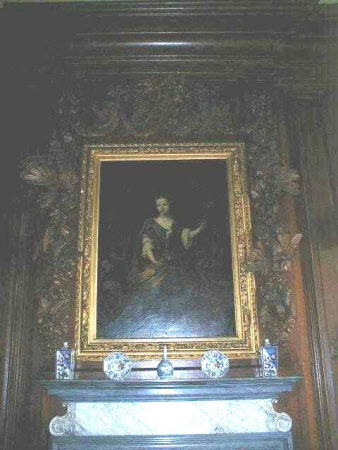Limewood overmantel with game birds, fruit, flowers and foliage
style of Grinling Gibbons (Rotterdam 1648 - London 1721)
Category
Art / Sculpture
Date
circa 1688
Materials
Limewood
Measurements
2000 x 1500 mm
Place of origin
England
Order this imageCollection
Belton House, Lincolnshire
NT 434858.1
Summary
Limewood, carved applique overmantel with gamebirds, fruit, flowers and foliage, in the style of Grinling Gibbons (1648-1721), late 17th century with 19th century restoration. A carved limewood applique overmantel comprised of a crest and two drops, installed in the west end of the Saloon at Belton House.
Full description
The drops consist of pigeon, pheasant, duck, woodcock or snipe hung among festoons of wheat, peapods, poppies and fruit. The crest of the overmantel consists of shamrock swags, a dead teal and woodcock and bunches of oak, hawthorn, wheat, pears, flowers and cobnuts tied in an elaborate bow of ribbon. The motif is close to NT 435033.1. Of this overmantel the Grinling Gibbons historian David Green writes: ‘…the birds are impressive: a cock with bristling neck feathers and a quacking duck might both have been lifted from Gibbons’ frame at Sudbury [Sudbury Hall, Derbyshire]…Here again, however, the head of the frame is disappointing, having a teal and a woodcock both facing the same way and a cluster of cobnuts poor enough to show how excellent Gibbons’ always were.’ (Green 1964, p.115). Green believes the carvings in the Saloon are the work of ‘several hands’, probably regional woodcarvers working in the Gibbons manner. The overmantel was probably produced around 1688 when Belton House was being newly furnished for ‘Young’ Sir John Brownlow (1659-97) and his wife Alice (1659-1721). Alice Rylance-Watson October 2018
Provenance
Purchased with a grant from the National Heritage Memorial Fund (NHMF) from Edward John Peregrine Cust, 7th Baron Brownlow, C. St J. (b.1936) in 1984.
Credit line
Belton House, The Brownlow Collection (acquired with the help of the National Heritage Memorial Fund by the National Trust in 1994)
Makers and roles
style of Grinling Gibbons (Rotterdam 1648 - London 1721), woodcarver
References
Green 1964: David Green, Grinling Gibbons: His work as carver and statuary 1648-1721, London 1964, pp.114-5 Esterly1998: David Esterly, Grinling Gibbons and the art of carving, V&A Publications, London 1998 Tipping, 1913: Henry Avray Tipping, Grinling Gibbons and the Woodwork of his Age 1648-1720, 1913
